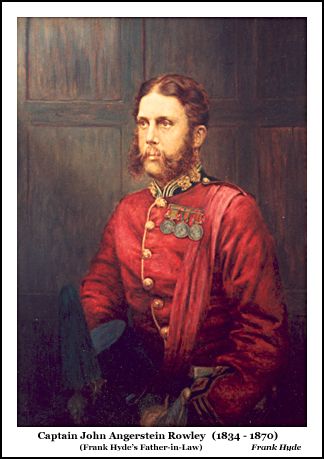''Captain John Angerstein Rowley'

''Captain John Angerstein Rowley'
|
|
Painted circa 1918 - 20" w x 30" h - oil) I think that this was painted by Frank from another painting or photograph and I will check with Elizabeth for more details. John Angerstein Rowley was a Captain in the 13th. Foot. Frank married Florence Ellen Louise Rowley on 1st. Nov. 1881. (His second marriage).
Elizabeth writes 22 June 2003:
I can remember my mother discussing the matter and persuading the Old Boy to do so. This was after he had copied Sir Thomas Lawrence's portrait of John Julius Angerstein in the National Gallery. He was issued with a permit in order to do this - which I have. If it is dated it will be a guide. I can remember visiting the N.G. in order to watch him work on it ..." Pam Hendy (nee Rowley) - who is a great-great granddaughter of Captain J.A. Rowley - forwarded to me on 17 July 2003 the following letter to her from Anthony Twist who I understand is researching some members of the Rowley family, in particular Sir John Julius Angerstein:
Dear Pam and Barbara, At the end of June 1855 they arrived at Balaclava in the Crimea and then were on working parties for two months at the base: at this time there was severe sickness and 62 deaths mainly from cholera. On 7th Sept they moved into advanced trenches for the first time and 11 men were wounded. on 8th Sept they were in reserve and the next day it was discovered that Sevastopol had been evacuated by the Russians. Oct 4th was a Day of Thanksgiving and finally peace was announced on March 30th 1856. The Crimean Medal with clasp for Sevastopol plus that granted by the Sultan of Turkey were awarded to a number of the officers of the regiment including Lt. J Angerstein Rowley. On 24th May 1856 they embarked for Gibraltar and arrived on June 7th. On 24th July they were ordered to proceed to Cape of Good Hope and arrived on 19th September at Port Elizabeth Algoa Bay; and they marched to Grahamstown. They were occupied with training etc until they were ordered to prepare for embarkation on 20th August 1857. They marched to Port Elizabeth (nearly 100 miles) in 4 days in heavy rain and hilly country. The regiment arrived at Calcutta in two parts in Oct 1857 and January 1858. They were not involved in the relief of Lucknow but took part in several other affrays. On 18th June 1858 150 men of the regiment formed part of a column commanded by Colonel Byng of the 6th Madras Light Cavalry with Lt. Rowley as orderly officer to Colonel Byng: he was among those favourably mentioned in dispatches in the action to take Hurryah. On 1st September 1858 Debreheah was taken by a force including 4 officers and 175 men of the Somersets under Captain Rowley [NB promotion!]. There were several other actions in which he may have been involved though he is not mentioned by name in the book; and he received the Indian Mutiny Medal. The regiment finally returned to England in 1864. After that, some men stayed at home while others went to Ireland in 1866 and Gibraltar in 1867; but I can't trace JAR's movements. I have put in dates as far as possible in the hope that you can tie them up with his marriage and the arrival of his children. It looks certain that the three medals he is wearing in the portrait are those I have mentioned above. There are lots of books about both the Crimean War and the Indian Mutiny but I haven't started on them! (I have added the emphasis to the medals - and thanks to Anthony for supplying this information) |
|
|
|
|
|